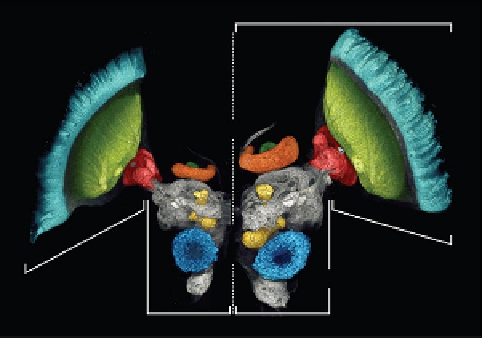Biology Reference
In-Depth Information
Solitarious
Gregarious
Total +27%*
+22%**
+13%**
acx
pcx
lo
+4%
-4%
+
me
-15%**
lb
la
-6%**
+8%
OL
AL
-13%**
MBr
+6%**
Figure 4.12
Body and brain changes between solitarious and gregarious locusts. Differences
in brain size and proportions of particular regions in solitarious (left) and gregarious (right)
brains of adult locusts are shown. Regions in the midbrain (MBr) include the olfactory
antennal lobe (AL) and three neuropils in the mushroom body: the olfactory primary calyx
(pcx), the gustatory accessory calyx (acx), and the multimodal lobes (lb). The optic lobe (OL)
comprises three successive visual neuropils: the lamina (la), the medulla (me), and the lobula
(lo). Absolute total brain size is 27% larger in gregarious locusts. The remaining numbers
refer to the differences in proportions of different brain regions relative to the total brain size.
Positive numbers indicate that a region is disproportionally larger in gregarious locusts than in
solitarious locusts (**
P
< 0.01; *
P
< 0.05; +
P
< 0.1).
Source
: From
Burrows et al. (2011)
.
locusts relate to the increased need for higher neural processing (
Burrows et al.,
2011
) (
Figure 4.12
).
The primary behavioral change is the aggregation behavior, the tendency to join
groups of other conspecifics and migrate by flying up to hundreds of kilometers
a day. Just 2 h of crowding is sufficient to induce a gregarious behavior similar to
that of the long-term gregarious locusts. Physiological changes involve numerous
changes in gene expression, but very characteristic and relevant to phase transition,
which seem to be the changes in 11 of 13 neurotransmitters and neuromodulators
analyzed in the nervous system of solitary and gregarious locusts (
Rogers et al.,
2004
). Eight of these neurotransmitters and neuromodulators were upregulated in
gregarious locusts (
Burrows et al., 2011
).
It is firmly established that transitioning from the solitarious to the gregarious
form is determined, initiated, and regulated by neural mechanisms, which within
hours are activated in response to various sensory (e.g., visual, olfactory, auditory,
and tactile) stimuli under natural and laboratory conditions, when the intensity of the
stimuli reaches the necessary threshold.
Given that all the perceptions (i.e., visual, olfactory, tactile, and auditory) inducing
phase transition take place in the locust brain, it would make sense to believe that the
brain is where the relevant phenotypic changes start or where the relevant information

Search WWH ::

Custom Search